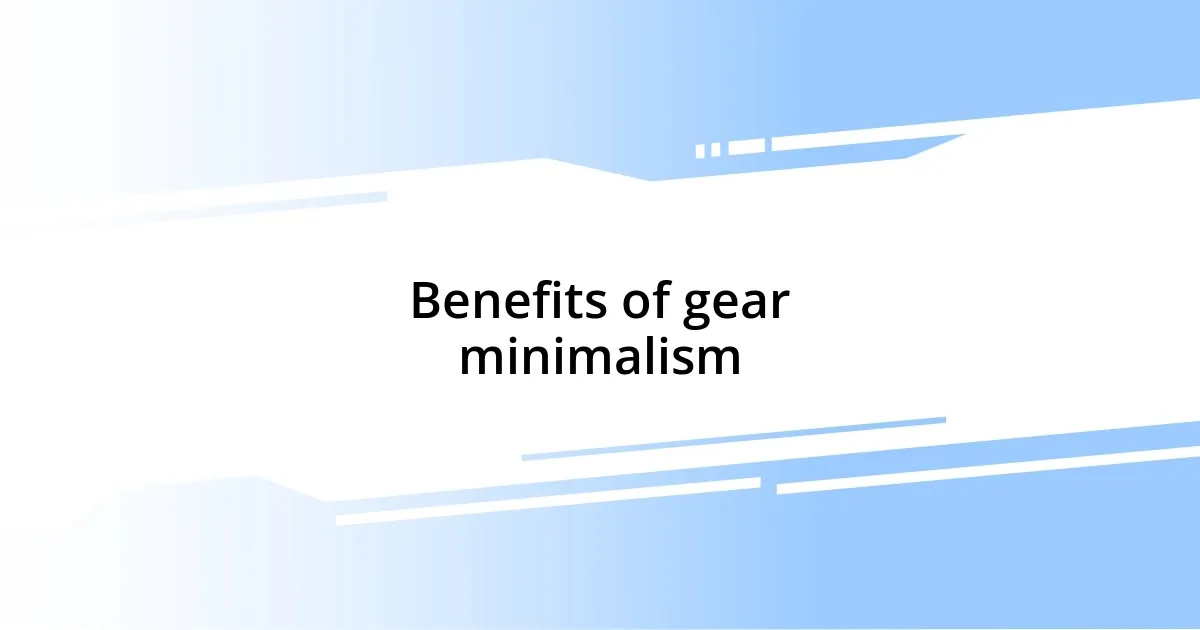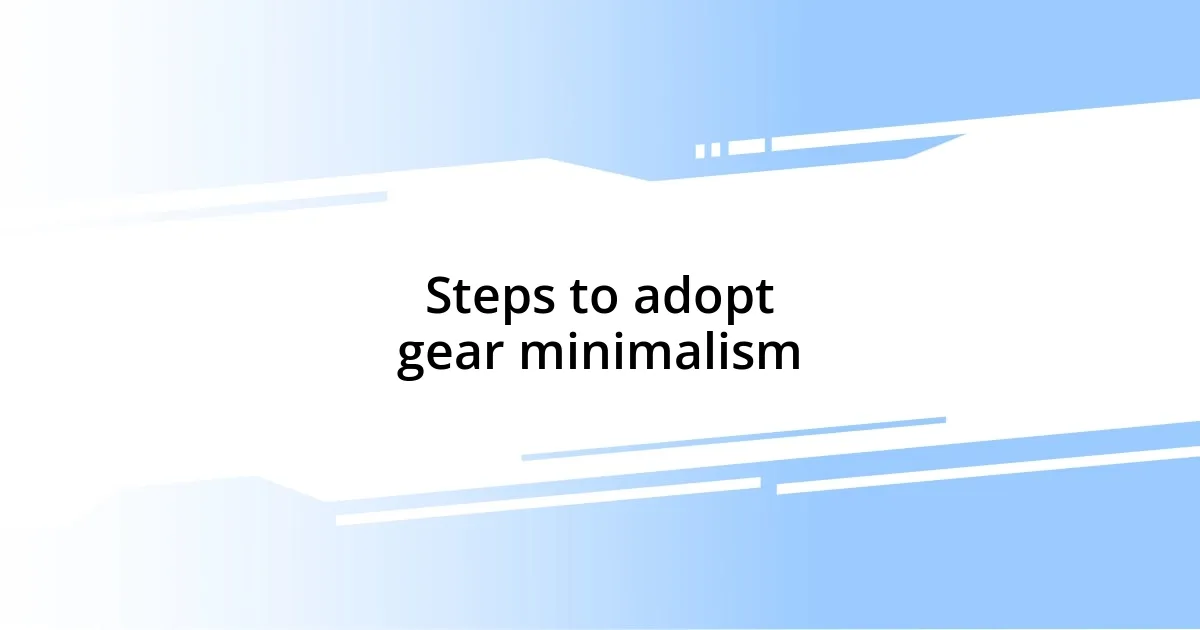Key takeaways:
- Gear minimalism emphasizes evaluating tools for necessity and enhancing experiences rather than accumulating possessions.
- Benefits include saving time, reducing stress, increasing flexibility, enhancing connection with nature, and promoting mindfulness.
- Key principles involve purposeful selection of gear and emotional evaluation, letting go of items that don’t add value.
- Adopting simple steps, such as categorizing items, embracing a “one in, one out” rule, and critically assessing emotional ties can facilitate gear reduction.

Understanding gear minimalism
Gear minimalism is all about streamlining your tools and equipment, focusing on what truly matters to you. I remember a time when my gear closet overflowed with gadgets I rarely used. It struck me—how many of these items genuinely contributed to my experiences?
The philosophy encourages you to evaluate each piece of gear through the lens of necessity and benefit. When I started shedding the excess, I felt an unexpected lightness. Have you ever noticed how much clearer your mind can become when you simplify? It’s liberating to keep only what enhances your adventures and joys.
Ultimately, embracing gear minimalism isn’t just about the stuff—it’s about creating space for experiences and relationships. As I learned to appreciate the essentials, my focus shifted from collecting to engaging wholeheartedly with my surroundings. It’s a rewarding transformation that I hope you can explore too.

Benefits of gear minimalism
Adopting gear minimalism can significantly enhance your overall experience. I recall an adventurous weekend hike where I decided to leave behind my bulky bag filled with unnecessary items. By packing only the essentials, I felt more agile and present in the moment, which allowed me to truly enjoy the stunning landscapes around me. This experience taught me that less really can be more when it comes to enjoying life’s journeys.
Here are some benefits of gear minimalism:
- Saves Time: Fewer items mean less time spent organizing and deciding what to take.
- Reduces Stress: A simplified gear list eliminates decision fatigue and makes it easier to focus on what really matters.
- Increases Flexibility: With lighter gear, I found myself more willing to explore new activities without the burden of excess equipment.
- Enhances Connection: Minimal gear encourages deeper engagement with nature and people instead of getting distracted by material possessions.
- Promotes Mindfulness: Focusing on essentials allows for a deeper appreciation of each moment, making experiences more memorable.

Key principles of gear minimalism
At its core, gear minimalism revolves around intentionally choosing tools that serve a specific purpose. I vividly recall a camping trip where I opted for just a versatile multi-tool instead of my usual array of gadgets. This shift not only tested my creativity but also deepened my appreciation for the utility of each item—an experience that reinforced the idea that quality truly outweighs quantity.
Another fundamental principle is evaluating the emotional connection each piece of gear holds. I once clung to an old camera, convinced it was essential because of the memories captured with it. However, when I streamlined my gear, I realized that those memories live within me, and the camera had become more of a weight than a treasure. It’s crucial to ask: Does this item enhance my life or merely occupy space?
| Principle | Description |
|---|---|
| Purposeful Selection | Choose only items that serve a specific function for your adventures. |
| Emotional Evaluation | Assess the emotional significance of your gear; let go of what doesn’t add value. |

Steps to adopt gear minimalism
To embrace gear minimalism, the first step is to conduct a thorough inventory of your belongings. I remember when I tackled my gear closet, pulling everything out and listing each item’s purpose—some quickly stood out as essentials while others seemed to gather dust. Have you ever realized how much weight you carry, both physically and emotionally, with items that serve no real function? Identifying those redundant pieces can feel liberating.
Once you’ve assessed your gear, it’s time to simplify your collection. I found it helpful to create categories—essentials, nice-to-haves, and items to let go of. This categorization not only helped me visualize what I truly needed but also prompted interesting questions: What adventures could I embark on if I only had what was essential? This process taught me the joy of making choices based on needs rather than attachments.
Finally, commit to a buying principle that limits new gear. I now ask myself, “Will this item truly enhance my experience?” If I can’t confidently say yes, I almost always opt to pass. I recall a time when I almost bought a fancy new backpack, but instead, I chose to invest in experiences—like that spontaneous weekend trip instead. Adopting this mindset transforms each purchase into a thoughtful decision rather than an impulse, keeping my adventures simple yet fulfilling.

Evaluating your gear collection
Evaluating your gear collection might seem straightforward, but I’ve learned it’s a process brimming with insights. When I took stock of my gear, I was taken aback by how many items I’d collected—pieces that had long lost their purpose. For instance, I discovered a headlamp I hadn’t used in years; instead of nostalgia, I felt a sense of relief as I let it go, recognizing that less clutter meant more clarity in my adventures.
As I reviewed each item, I began to reflect on its impact on my experiences. Do you ever have those moments where a piece of gear keeps tugging at your heartstrings, despite hardly being used? I faced this exact dilemma with an old hiking jacket. It was a beloved companion on countless trails, but it had been sitting in storage. Realizing it offered more of a memory than functionality shifted my perspective—my experiences were etched in my mind, not in the fabric.
The emotional connections can complicate our evaluations, which is why I urge you to think critically about each item you own. When I finally decided to let go of my hefty collection of camping pots, I felt lighter, both emotionally and physically. What once seemed a daunting task turned into a journey of self-discovery—what do I genuinely need versus what I feel I should keep? Each decision became a form of empowerment, teaching me that the tools for adventure can—and should—be as uncomplicated as the adventures themselves.

Practical tips for gear reduction
When it comes to gear reduction, starting small can make a huge difference. I often recommend tackling one category at a time—like clothing or tools—to avoid feeling overwhelmed. The last time I focused on my camping gear, I discovered I had three sleeping bags while only needing one! Isn’t it funny how we accumulate things without even realizing it?
Another effective tip is to embrace the “one in, one out” rule. I find it helps to think of my available space as precious real estate. For every item I consider adding to my collection, I make a conscious decision to part with something else. This practice not only curbs unnecessary purchases but also creates a more mindful approach to what I truly value. Have you ever had that regretful moment after buying something new, only to realize it just doesn’t fit into your life?
Lastly, consider the emotional ties to your gear that might be holding you back. I once had a beloved pair of hiking boots that had seen better days; they held memories of exhilarating treks. Yet, keeping them felt more like a burden as each hike turned painful. Letting go can be daunting, but I learned that embracing new adventures with fresh gear can be just as fulfilling. What does your gear truly represent for you? Each piece should inspire you, not weigh you down.












